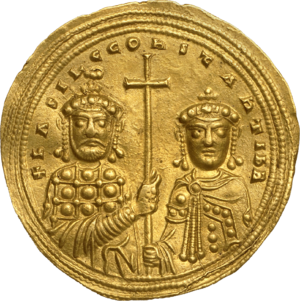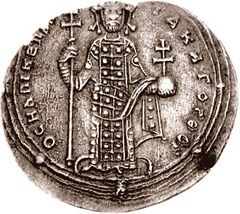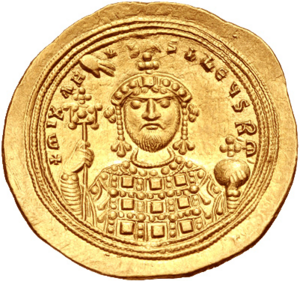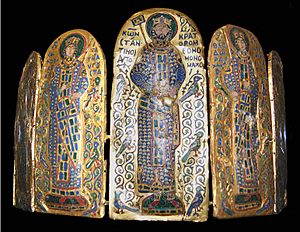Zoe Porphyrogenita facts for kids
Quick facts for kids Zoë Porphyrogenita |
|
|---|---|
| Empress and Autocratess of the Romans | |
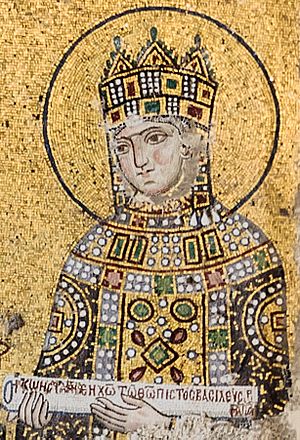
Contemporary mosaic of Zoë presenting a scroll to Jesus Christ, at Hagia Sophia: a caption (not shown) reads, "Zoë, the very pious Augusta"
|
|
| Byzantine empress regnant | |
| Reign | 21 April 1042 – 11 June 1042 |
| Coronation | 21 April 1042 |
| Predecessor | Michael V Kalaphates |
| Successor | Constantine IX |
| Alongside | Theodora |
| Byzantine empress | |
| Tenure | 1028–1042 and 1042–1050 |
| Emperors | Romanos III (1028–1034) Michael IV (1034–1041) Michael V (1041–1042) Constantine IX (1042–1050) |
| Born | c. 978 Constantinople (now Istanbul, Turkey) |
| Died | 1050 (aged 72) Constantinople |
| Burial | Constantinople |
| Spouse | Romanos III (1028–1034) Michael IV (1034–1041) Constantine IX (1042–1050) |
| Issue | Michael V (adopted) |
| Dynasty | Macedonian |
| Father | Constantine VIII |
| Mother | Helena |
Zoë Porphyrogenita (born around 978, died 1050) was a powerful Byzantine Empress. She belonged to the Macedonian dynasty. Zoë ruled briefly as empress in 1042 with her sister Theodora. Before that, she was empress alongside several emperors, two of whom she married.
Zoë was born when her father, Constantine VIII, was a co-emperor with his brother, Basil II. A plan for her to marry Holy Roman Emperor Otto III in 996 did not happen. Zoë then spent many years living in the imperial palace. When Basil II died in 1025, Zoë was 47 years old. Her father, Constantine VIII, became the sole emperor. Since he had no sons, Constantine wanted one of his daughters to marry and continue the family line.
Zoë, at 50, married Romanos Argyros. They became emperor and empress the day after her father died. Their marriage was difficult. Romanos III died in 1034. Zoë married Michael on the same day. He became Emperor Michael IV the next day. In 1041, Zoë adopted Michael's nephew, Michael Kalaphates.
After Michael V became emperor, he sent Zoë away. This caused a large public uprising. The people removed Michael V from power. They made Zoë and her sister Theodora joint empresses. After ruling together for two months, Zoë married Constantine IX. She gave him power, but she continued to rule as the Byzantine empress. Zoë died eight years later, at 72. During her time, the Byzantine army became weaker. The Turks also began to enter eastern Anatolia.
Contents
Early Life: About 978–1028
Zoë was called Porphyrogenita. This means "born into the purple." It was a special name for a child born in the capital city while their father was the reigning emperor. She was the second daughter of Constantine VIII and his wife Helena. Her father had been a co-emperor since he was two years old, starting in 962.
His brother, Basil II, who was the main ruler, did not let his nieces marry any Byzantine nobles. This was because marrying a noble would give their husbands a claim to the throne. As women, Zoë and her sisters could not hold state power themselves. Their main role was to choose a husband who would then gain their authority. Because of this, Zoë lived a quiet life in the palace's women's quarters for many years.
As a royal princess, Zoë was considered a possible bride for the Holy Roman Emperor, Otto III, in 996. Another group of officials was sent in 1001. They were to choose Otto's bride from Constantine's three daughters. The oldest, Eudocia, had smallpox scars. The youngest, Theodora, was described as plain. So, the officials chose the attractive 23-year-old Zoë. Basil II agreed to this. In January 1002, Zoë traveled to Italy. But when her ship reached Bari, she learned that Otto had died. She had to return home.
When Basil II died, Constantine VIII became the sole emperor. His rule lasted less than three years, from December 15, 1025, to November 11, 1028. Another chance for Zoë to marry came in 1028. Officials from the Holy Roman Empire arrived in Constantinople with a marriage proposal. Constantine and Zoë refused the idea. The groom, Henry, was only ten years old.
Constantine decided that one of his daughters must marry a suitable noble to continue the ruling family. The first choice was Constantine Dalassenos. He was a respected noble and a former governor. The emperor's advisors wanted a weaker ruler they could control. They convinced him to reject Dalassenos, even after he had been called to the capital.
Romanos Argyros, a city official in Constantinople, was the next choice. Theodora refused to marry Romanos. She said he was already married, and his wife had been made a nun. She also argued that they were too closely related by blood. So, Constantine VIII chose Zoë to be Romanos's wife. Zoë and Romanos married on November 10, 1028, in the palace chapel. The next day, Constantine died. The newlyweds then took their places on the imperial throne.
From Romanos III to Michael V: 1028–1042
Zoë had lived in the same palace quarters as her sister Theodora for years. Zoë had come to dislike Theodora. Zoë convinced Romanos to appoint one of his own men to watch Theodora's household. Soon after, Theodora was accused of planning to take the throne. This happened first with Presian in 1030, then with Constantine Diogenes in 1031. Zoë said Theodora was part of the plot. Theodora was then forced to stay in a monastery. Zoë later visited her sister and made her take religious vows.
Zoë was very keen on continuing the Macedonian family line. Almost immediately after marrying Romanos, the fifty-year-old Zoë tried hard to become pregnant. She used many methods, but nothing worked. This failure made the couple grow apart. Soon, Romanos refused to share their marriage bed. Romanos also limited his wife's spending and paid her little attention.
Zoë became very angry and frustrated. She started relationships with other men. Romanos allowed this and also had a relationship with another woman. In 1033, Zoë became fond of a servant named Michael. She openly showed her affection for him. She even talked about making him emperor. Rumors about her behavior led Romanos to confront Michael. Michael denied wanting the throne.
In early 1034, Romanos became ill. Many people believed that Zoë and Michael were planning to harm him. On April 11, Romanos was found dying in his bath. Some historical accounts suggest Romanos was drowned on Michael's orders. Other accounts say Zoë poisoned Romanos.
Zoë and Michael married on the same day Romanos III died. The next day, they called the Patriarch Alexios I. They wanted him to crown the new emperor. The Patriarch first refused. But after receiving a large payment, he changed his mind. Zoë's new husband became Emperor Michael IV.
Michael's sudden rise to power meant he was not ready to rule. He gave much of the governing work to his brother, John the Orphanotrophos. Zoë thought Michael would be a more loving husband than Romanos. But she was wrong. Michael feared Zoë might turn against him, just as she had with Romanos. So, Michael kept her out of politics. He sent her back to the women's quarters. There, she was watched very closely. The unhappy empress tried to change things by plotting against John, but she was not successful.
Michael's health was poor throughout his rule. By 1041, it was clear he was dying. John the Eunuch wanted to keep power in his family. He made Zoë adopt his nephew Michael Kalaphates. On December 10, 1041, Michael IV died. He refused to see his wife, who begged to visit him one last time. Kalaphates was crowned emperor as Michael V.
Michael V had promised to respect Zoë. But he quickly sent her away to a monastery on Principus Island. He accused her of trying to kill him. She was forced to cut her hair short and become a nun. This treatment of the rightful heir to the Macedonian family caused a large uprising in Constantinople.
Michael V was desperate to keep his throne. He brought Zoë back from Principus and showed her to the people. But his demand to rule alongside her was useless. On April 19, 1042, the crowd rebelled against Michael V. They supported not only Zoë but also Theodora.
A group of important officials went to the monastery where Theodora was. They wanted to convince her to become co-empress with her sister. Theodora had grown used to a quiet religious life. She tried to refuse the offer. But the officials brought her back to the capital by force. At a gathering in Hagia Sophia, the people led a very angry Theodora and declared her empress along with Zoë. They were both crowned on April 21. Michael V was forced to hide in a monastery.
Ruling with Theodora and Constantine IX: 1042–1050
Zoë immediately took power. She tried to send Theodora back to her monastery. But the Senate and the people demanded that the sisters rule together. Theodora's first task was to deal with Michael V. Zoë wanted to forgive and free Michael. But Theodora was firm. She first promised Michael's safety. Then she ordered him to be blinded. He spent the rest of his life as a monk.
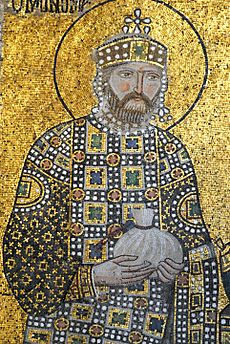
Officially, Zoë was the senior empress. Her throne was placed slightly in front of Theodora's at all public events. But in reality, Theodora was the main leader of their joint government. The sisters worked to manage the empire. They focused on stopping the sale of public offices and on making justice fair. One historian, Michael Psellus, said their joint rule was a failure. However, another historian, John Scylitzes, said they worked hard to fix problems from earlier reigns.
Theodora and Zoë appeared together at Senate meetings and met with the public. But it soon became clear that their joint rule was difficult. Zoë was still jealous of Theodora. She did not want to manage the empire herself. But she also would not let Theodora handle public business alone. The court started to divide, with groups supporting each empress. After two months of growing arguments, Zoë decided to find a new husband. This would stop Theodora from gaining more power. According to the rules of the Orthodox Church, this would be her third and last marriage.
Zoë preferred Constantine Dalassenos. He had been her father's first choice for her husband back in 1028. He was brought to meet the Empress. But during their talk, his independent and strong personality did not please Zoë. She sent him away. Her next choice was Constantine Atroklines, a court official who was already married. He died under unclear circumstances a few days before the wedding.
Zoë then remembered Constantine Monomachos. He was handsome and refined, and a former lover. They married on June 11, 1042. Patriarch Alexios did not take part, as he refused to oversee a third marriage for either of them. Constantine was crowned by the patriarch the next day.
Zoë got more than she expected. Constantine decided to bring his long-time partner, Maria Skleraina, to his new position. He wanted to openly share his life with her. He also wanted her to receive some official recognition. The 64-year-old Zoë did not object to sharing her life and throne with Skleraina. Skleraina was given the title of sebaste. She ranked below Zoë and Theodora. She was also called mistress or empress, like them. At official events, Skleraina stood right behind the sisters.
However, the public saw Constantine IX's special treatment of Skleraina as a scandal. Rumors began to spread that Skleraina planned to kill Zoë, and possibly Theodora. This led to a public uprising in Constantinople in 1044. The crowd almost harmed Constantine, who was in a religious procession. The mob only calmed down when Zoë and Theodora appeared on a balcony. They assured the people that they were safe.
It is said that Zoë was very beautiful. Historian Michael Psellos wrote that "every part of her was firm and in good condition." Zoë knew her beauty was important. She tried to keep it and make it last with various treatments. She had a cosmetics laboratory in the women's quarters. She was said to have experimented to make perfumes and ointments better. Psellus reported that her face looked young even when she was in her sixties. Zoë died in 1050, at the age of 72. She was buried in Constantinople.
See also
 In Spanish: Zoe para niños
In Spanish: Zoe para niños


